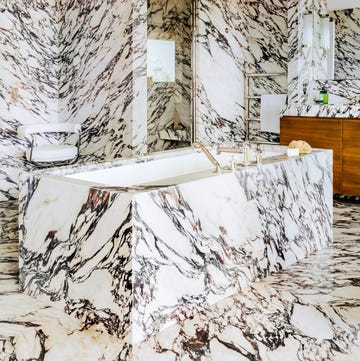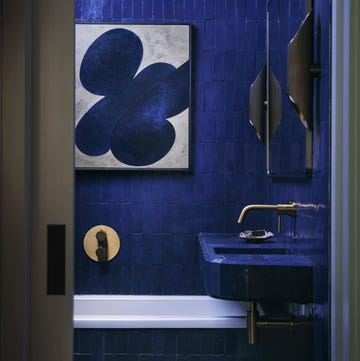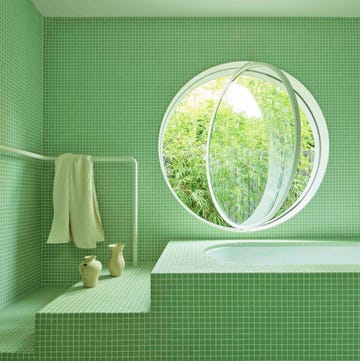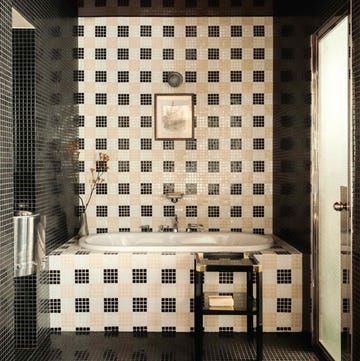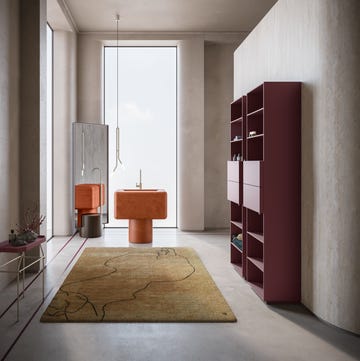Clashing patterns, explosions of colour, glossy zellige to encaustic – tiles are increasingly being used to make a statement in the bathroom. These aren’t your traditional tiling schemes; they are more inventive and rule-breaking. ‘I like to be bold in bathrooms as a provocative gesture,’ Brazilian architectural designer Teresa Barra tells us. ‘The bathroom is a functional space, and people tend to believe that function is disconnected from beauty and art. I choose to reflect on how a space so technical can be playful and interesting. I like to think of the bathroom as an intimate space. It’s where we are at our most vulnerable. Daring there is almost an act of care, a way to make the everyday more poetic.’
It’s an ethos shared by Turkish designer Omer Ozturk. ‘In my opinion,’ he says, ‘bathrooms are the only place that you can design freely and fearlessly.’ Ozturk’s designs are especially maximalist. In one project, he chose chequerboard tiling in different sizes and colours within the same room, while in a house he recently renovated, a geometric washbasin is clad in a patchwork of multicoloured tiles that emphasise its striking, Tetris-like appeal.
‘People might avoid choosing vibrant tiles in the kitchen or other parts of the house that are more high-traffic, but in spaces like bathrooms, they can create the right combinations and a design approach that emphasises experimentation,’ he encourages.
What's everyone reading?
A creative take on tiling may not look quite as maximalist for everyone, and that’s okay too. For American interior designers Louisa Pierce and Emily Ward, founders of Pierce & Ward, bold tiling can mean an all-encompassing, cohesive approach. They advise covering the walls and ceiling (especially in areas like a shower enclosure), enjoying how it creates ‘unexpected jewel-box moments’.
The duo believe that bathrooms are the ideal place to try out ideas like this, because it’s not ‘overstimulating’. ‘You’re not spending your entire day there, just popping in and out, making it a great space to test your boundaries when it comes to style.’ Their approach shares much in common with British interiors star Tiffany Duggan. In a small guest shower room for a project in Notting Hill, she lacquered the walls and ceiling a deep red and clad the shower in glimmering red-and-cream chequered zellige mosaic tiles. The masterstroke, though, is mimicking the tiling pattern on the skirting and the splashback above the basin. ‘Contrast is key,’ she notes, so the floor is kept simple with a nude cement tile.
There are so many different types of tile to choose from – the possibilities are endless, but decisions can be daunting. Duggan adores the handmade reflective quality of Moroccan zellige tiles and often uses them to bounce light around bathrooms, like the one in her recent Notting Hill redesign. ‘You can’t go wrong with a crackle-glazed tile either,’ she believes, ‘and hand-painted tiles from Petra Palumbo or Balineum are wonderfully decorative – even if only used as a small splashback or border tile.’
Others, like Owl Design Studio’s Sophie van Winden and Simone Gordon, prefer the matte beauty of encaustic tiles. For a home in Herne Hill, they combined three colours from Mosaic Tile’s encaustic range to wrap the floor, bath surround and steps leading up to the tub in a Neopolitan-ice-cream-like block pattern that is pure indulgence. ‘We paired the tiles with a wider grout line to give the pattern a fresher, more graphic feel,’ say the pair.
Of course, you don’t necessarily have to pick a side. Teresa Barra is a fan of a more mix-and-match approach to tiling. ‘In a single bathroom, I sometimes combine several types as well as colours of tiles, creating a kind of mosaic,’ she says, explaining that you can create a unique composition using these differing puzzle pieces. When the tile is particularly interesting (like the heart-emblazoned one she discovered from Sāo Paolo-based illustrative-tile studio Hausfrau for a recent bathroom project), it can be fun to use it in unconventional ways, like cladding a vanity unit or top, ‘breaking with tiling’s traditional role’.
Owl Design’s Van Winden and Gordon point to how hotel bathrooms have become increasingly Instagram-worthy as an inspiration for people’s increased bravery when it comes to tiling. ‘Clients want to capture that same sense of escape and indulgence,’ they share, but there are some practical concerns to consider before you go wild with the tiles.
For them, it’s the details that can make or break a scheme. ‘If you’re mixing tile sizes on the floor and wall, make sure they line up properly. For example, if your floor tiles are 60cm, opt for wall tiles that divide evenly (30, 20 or 10cm), so that everything flows visually. It makes a huge difference to the overall finish.’ Plus, you don’t want your tile choice to literally knock people out, so consider how it will work underfoot. Pierce and Ward warn that you should be extra-careful when it comes to the shower floor – ‘you want the grout line to be at the same level or higher than the tile, because otherwise it can become very slippery. Also, always use a small-scale tile as that will help with grip’.
It is agreed that now is the time to be adventurous in the bathroom, but is there also a consensus on what to avoid? As always, it’s very much personal taste, but there are a few tired tiling tropes that our experts are keen to see go down the drain. For Duggan, it’s 1990s-style travertine tiles that should enter the design graveyard. ‘We are over those beige suites and ready to embrace something more soulful and personal,’ she says. ‘Not to say I don’t love travertine on occasion, but there is a time and a place.’
Grey is also out – ‘very clinical and cold’. For Barra, it’s a firm no to large-format tiles, as it’s the act of combining smaller handcrafted designs that creates charm. ‘I also see tiles that imitate other materials – like concrete, wood or marble – as dated,’ she adds. ‘I prefer the authenticity of the materials themselves.’ Even the classic metro tile doesn’t escape without some ire. ‘They’ve been overdone in a very safe way,’ say Van Winden and Gordon. ‘If you’re drawn to them, try rethinking the layout – maybe a dual-colour scheme or grouping them in blocks laid at different angles to create a pattern with rhythm.’
‘The bathroom is one of the only rooms in the home that people are usually alone in,’ says Ozturk, who believes that it is the solitary nature of these sanctuaries that should empower people to please themselves when it comes to style. ‘It is very important to show courage in these spaces,’ adds the designer, who admits that his own design decisions are very often driven by emotional responses. ‘When someone enters their bathroom, it should elicit a feeling – they should want to say, “Wow!”’












